So this is our final week on “The Rock” before heading back to France. It’s been a short stay this time and the weather has been dreadful with rain most days. Hope it’s not an omen for the summer! Last year we had a thoroughly splendid summer and we went walking almost every day. Unless something changes soon, this summer could be a washout, just like 2012.
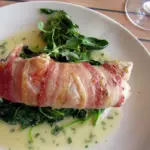 By way of marking our return to France, we invited our friends and neighbours, Terry, Julie, Dominic and Kate to dinner last night. We kicked off in normal style with a glass or two of Kir, using a rather nice Chardonny that had travelled back with us in January. When we settled at the table, we started with Monk Fish in Bacon with Parsley Cream which we haven’t done for a little while, but never fails to please. It’s light, tasty and visually pleasing, so it easily meets all the right criteria. We served the same Duc de Morny 2012 Picpoul de Pinet that we have served a couple of times recently. It’s light and fresh and it’s a wine that won the Medaille d’Or in the 2013 Agricultural and Food show in Paris.
By way of marking our return to France, we invited our friends and neighbours, Terry, Julie, Dominic and Kate to dinner last night. We kicked off in normal style with a glass or two of Kir, using a rather nice Chardonny that had travelled back with us in January. When we settled at the table, we started with Monk Fish in Bacon with Parsley Cream which we haven’t done for a little while, but never fails to please. It’s light, tasty and visually pleasing, so it easily meets all the right criteria. We served the same Duc de Morny 2012 Picpoul de Pinet that we have served a couple of times recently. It’s light and fresh and it’s a wine that won the Medaille d’Or in the 2013 Agricultural and Food show in Paris.
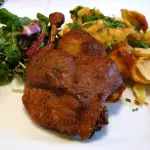 After which, we resorted to one of our regular favourites, Confit de Canard and although it may seem that we are “over-relying” on this, having eaten it a few weeks ago, we are conscious that it is simply not available in provincial Britain so, while we may be used to it, our guests always seem pleased to have it placed in front of them. As usual, we served it in traditional French style, simply with a potato/mushroom mix. For this, we prepare Sautée Potatoes but we add cepes and/or porcino mushrooms (same family – Boletus edulis, commonly known as penny bun). The secret is to gently cook the mushrooms on their own first, to remove the water and then mix them into the potatoes at the last moment.
After which, we resorted to one of our regular favourites, Confit de Canard and although it may seem that we are “over-relying” on this, having eaten it a few weeks ago, we are conscious that it is simply not available in provincial Britain so, while we may be used to it, our guests always seem pleased to have it placed in front of them. As usual, we served it in traditional French style, simply with a potato/mushroom mix. For this, we prepare Sautée Potatoes but we add cepes and/or porcino mushrooms (same family – Boletus edulis, commonly known as penny bun). The secret is to gently cook the mushrooms on their own first, to remove the water and then mix them into the potatoes at the last moment.
One of the joys of this main course is that just about everything can be prepared beforehand and then quickly warmed just before serving. I leave the stove on very low beneath the potatoes and the confit while we eat our starter. Then, I return to the kitchen turn up the heat, flip the confit so it is skin-side down (important to get that skin nice and crispy!) and it’s ready to serve in just a few minutes. We served it with a Gaillac – a Chateau d’Escabes 2008. This lovely ruby-coloured red wine from just north of Toulouse has an intense ‘nose’ of red fruits, spices and vanilla while remaining silky in the mouth. It worked well both during the main course and the cheese that followed.
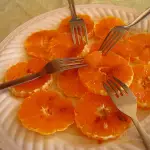 Our dessert was a chocolate and nut gateau that M-D had made using walnuts from her daughter’s garden in The Loire region of France. We served this with orange slices sprinked with orange zest that had been cooked in cinnamon sugar and, just to give a contrast, we mixed normal oranges and blood oranges as we arranged them on the plate. Naturally, there being plenty of chocolate in the cake, we served Mas Amiel with its dense and concentrated inky black Grenache grapes and its complex nose of tobacco and garden herbs.
Our dessert was a chocolate and nut gateau that M-D had made using walnuts from her daughter’s garden in The Loire region of France. We served this with orange slices sprinked with orange zest that had been cooked in cinnamon sugar and, just to give a contrast, we mixed normal oranges and blood oranges as we arranged them on the plate. Naturally, there being plenty of chocolate in the cake, we served Mas Amiel with its dense and concentrated inky black Grenache grapes and its complex nose of tobacco and garden herbs.
Coffee and chocolates took us into the wee hours until we finally crashed and left the washing up until today – lovely getting up to a mess, isn’t it! What was lovely, however, was spending a few hours in good company. We all know each other well enough now to simply be ourselves and not worry about being politically correct or having to choose our words with care. So an evening of good food, good company and good conversation seems like the ideal way to once again leave The Rock and head back to La Belle France.
We’ll be back!
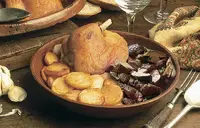 For the main course, we took an easy option (for us) and served
For the main course, we took an easy option (for us) and served 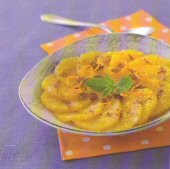 After a selection of cheeses (with a little more St Emilion!), dessert was a Gâteau Creusois and a Carpaccio d’Oranges à la Cannelle (Orange slices with cinnamon). Together, a nice simple, refreshing and tasty way to finish the meal (particularly since it took a new bottle of Saint Emilion to help it go down!).
After a selection of cheeses (with a little more St Emilion!), dessert was a Gâteau Creusois and a Carpaccio d’Oranges à la Cannelle (Orange slices with cinnamon). Together, a nice simple, refreshing and tasty way to finish the meal (particularly since it took a new bottle of Saint Emilion to help it go down!). Meanwhile, a combination of storms and high tides has given The Island a real pounding with many of the sea walls damaged, some shops and homes flooded and everybody huddled indoors waiting for summer! Fortunately, the island is hilly, so we don’t get many places where water lays on the land for long periods such as they are experiencing in Somerset.
Meanwhile, a combination of storms and high tides has given The Island a real pounding with many of the sea walls damaged, some shops and homes flooded and everybody huddled indoors waiting for summer! Fortunately, the island is hilly, so we don’t get many places where water lays on the land for long periods such as they are experiencing in Somerset. However, all’s well that ends well because Penny is coming round tomorrow night to help us finish the raclette ingredients that we had with Terry and Julie last week! We have just enough for three people, Steve’s away and Penny’s not on call, so it sounds like a good excuse to dig into the wine cellar and see what’s available – I love it when a plan comes together! Who cares about the weather?
However, all’s well that ends well because Penny is coming round tomorrow night to help us finish the raclette ingredients that we had with Terry and Julie last week! We have just enough for three people, Steve’s away and Penny’s not on call, so it sounds like a good excuse to dig into the wine cellar and see what’s available – I love it when a plan comes together! Who cares about the weather?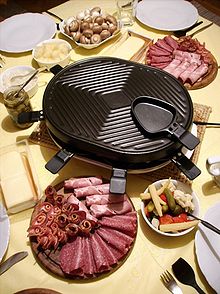 Obviously, we didn’t buy a 50kg block of cheese, light a fire and start scraping it – we used a more modern way of serving raclette that involves an electric table-top grill with small pans, known as coupelles, in which to melt slices of cheese. When we do this, we bring the cheese to the table already cut and sliced, along with a plate of charcuterie like Grisons (which is what we used last night) or pastrami or salami or cooked ham (or whatever floats your boat) accompanied by a big dish of boiled or steamed potatoes and a bowl of cornichons (small gherkins).
Obviously, we didn’t buy a 50kg block of cheese, light a fire and start scraping it – we used a more modern way of serving raclette that involves an electric table-top grill with small pans, known as coupelles, in which to melt slices of cheese. When we do this, we bring the cheese to the table already cut and sliced, along with a plate of charcuterie like Grisons (which is what we used last night) or pastrami or salami or cooked ham (or whatever floats your boat) accompanied by a big dish of boiled or steamed potatoes and a bowl of cornichons (small gherkins).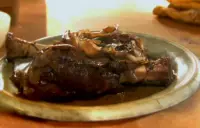 It had to be simple and straightforward, so we opted for foie gras as a starter,
It had to be simple and straightforward, so we opted for foie gras as a starter,  The day before, I had prepared a
The day before, I had prepared a 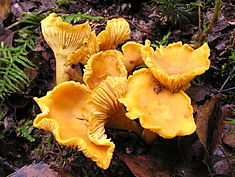 On this occasion there was a fresh supply of Chanterelles (known in France as Girolles) in the local supermarket so we waded in and chose the best before anyone else could get near them (yes, I know, we’re not very polite are we!). However, we made allowances for nine-year-old Eléonore who decided a long time ago that she didn’t like mushrooms, and we bought some fresh asparagus for her.
On this occasion there was a fresh supply of Chanterelles (known in France as Girolles) in the local supermarket so we waded in and chose the best before anyone else could get near them (yes, I know, we’re not very polite are we!). However, we made allowances for nine-year-old Eléonore who decided a long time ago that she didn’t like mushrooms, and we bought some fresh asparagus for her.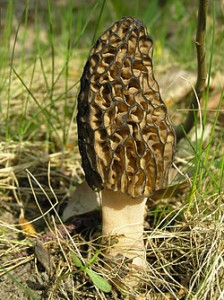 So be on the lookout for “unusual” mushrooms. We particularly like Chanterelle (as you may have gathered!), Cèpes and Morels. The Morel (shown on the right) is from the mushroom family “Morchella” and is closely related to anatomically simpler cup fungi. These distinctive mushrooms appear honeycomb-like in that the upper portion is composed of a network of ridges with pits between them.
So be on the lookout for “unusual” mushrooms. We particularly like Chanterelle (as you may have gathered!), Cèpes and Morels. The Morel (shown on the right) is from the mushroom family “Morchella” and is closely related to anatomically simpler cup fungi. These distinctive mushrooms appear honeycomb-like in that the upper portion is composed of a network of ridges with pits between them.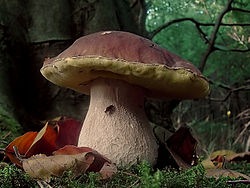 Cèpes is the local name (in France) for one of the Boletes group of edible mushrooms (of which there are over 100 species!). Probably the most common is the Boletus Edulis, commonly known as penny bun, porcino or even cep (in English). Commonly prepared and eaten in soups, pasta, or risotto, the mushroom is low in fat and digestible carbohydrates, and high in protein, vitamins, minerals and dietary fibre. It’s also very, very good (again) with such as
Cèpes is the local name (in France) for one of the Boletes group of edible mushrooms (of which there are over 100 species!). Probably the most common is the Boletus Edulis, commonly known as penny bun, porcino or even cep (in English). Commonly prepared and eaten in soups, pasta, or risotto, the mushroom is low in fat and digestible carbohydrates, and high in protein, vitamins, minerals and dietary fibre. It’s also very, very good (again) with such as